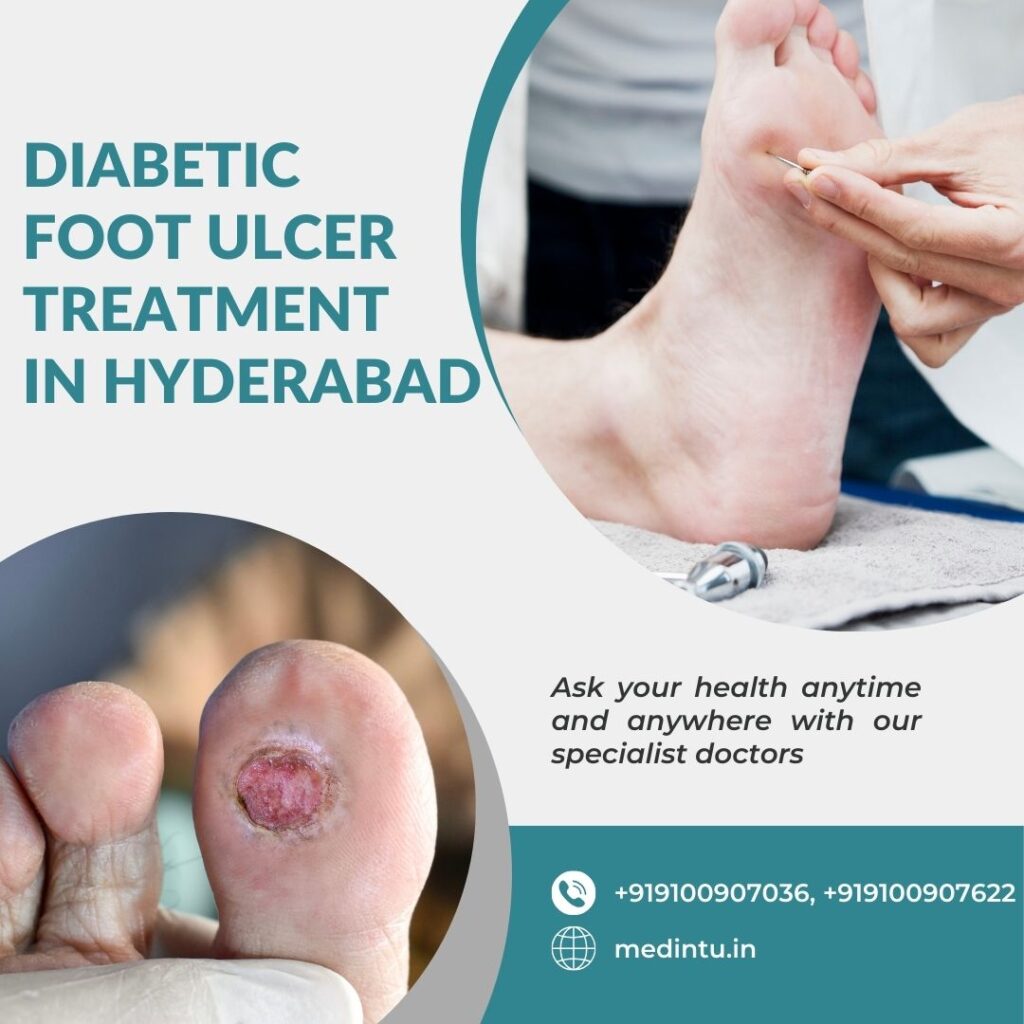Diabetic Foot Ulcer Treatment In Hyderabad
In today’s world diabetes has become a common issue among middle-aged to the aged population. A major complication caused by Diabetes is a Diabetic Foot Ulcer. Most of the time a wound on the foot taking time more than required in a diabetic patient is misinterpreted as a normal wound and ignored. But they could be diabetic foot ulcers and much more to it if left untreated. Let us dive deeper into the topic and understand what these wounds are and how they can be treated by specialists in Hyderabad. Book an appointment now with our range of renowned specialists through Medintu. Wait no further and explore our page.

Fill out form to enquire now
Understanding Diabetic Foot Ulcers and its Causes
Diabetic foot ulcers are a major complication of Diabetes mellitus, formed by the breaking down skin or deeper tissues causing open sores or wounds due to various factors. These ulcers are thought to occur due to abnormal pressure, applied on the foot accompanied by primary conditions such as peripheral neuropathy, autonomic neuropathy or peripheral arterial disease. Secondary conditions involve infection of the skin or bone, tissue situated under the skin or gangrenes leading to amputations in most cases. Understanding the causes, symptoms, and treatment for diabetic foot ulcers is crucial for effective management and prevention. In normal cases, wounds naturally heal through a mechanism of stepwise healing or repairing. But in certain conditions, this process is delayed or disturbed. One such metabolic condition is diabetes which makes natural healing difficult and time-consuming.
Our Diabetic Foot Ulcer Specialists
Medintu offers highly reputable General Surgeons who will guide you in your Diabetic Foot Ulcer treatment.

Dr. G.V. Rajgopal

Dr. Gujar Shivanand

Dr.NR Baldwa

Dr. A. Sarath Kumar Reddy
What are the Risk Factors Involved
Diabetic foot ulcers result from a combination of factors, including:
- Diabetic Neuropathy: Various types of Nerve damage leading to symptoms depending on the area affected.
- Poor Circulation: Reduced blood flow slows the healing process.
- Hyperglycemia: High blood sugar levels impede immune response and healing.
- Prior history of foot disease
- Old age
- Callus at pressure areas.
Symptoms of Diabetic Foot Ulcers
Early detection of diabetic foot ulcers is key to preventing complications. Diabetic Foot Ulcer Symptoms include:
- Dry or cracked skin.
- Loss of feeling or ability to sense heat or cold
- A sore (like a blister or ulcer) that won’t heal.
- Redness and swelling around the wound
- Drainage or pus from the ulcer
- Odor emanating from the ulcer
- Pain and tenderness in the affected area
Stages of Diabetic Foot Ulcer
The stages of diabetic foot ulcers show you the severity of the ulcer through a system of grading called the Wagner grades.
- Grade 0: No ulcer, but could develop one in the future.
- Grade 1: Ulcer just on the surface, and does not involve underlying tissues.
- Grade 2: An ulcer that involves even the ligaments but not the bone yet.
- Grade 3: An ulcer causing inflammation, could have infections in the muscle or bone
- Grade 4: Front foot Gangrene
- Grade 5: Whole foot Gangrene
Treatment Options
In normal cases, wounds naturally heal through a mechanism of stepwise healing or repairing. But in certain conditions, this process is delayed or disturbed. One such metabolic condition is diabetes which makes natural healing difficult and time-consuming. Depending on the wound’s level, the specialist suggests a relevant treatment.
Non-Surgical Treatments
- Wound Care: Regular cleaning and dressing of the ulcer.
- Offloading: Using special footwear to reduce pressure on the ulcer.
- Antibiotics: To treat any underlying infection.
Surgical Treatments
When non-surgical treatments are insufficient, surgical intervention may be necessary. Surgical options for diabetic foot ulcer treatment include:
- Debridement: Removing dead or infected tissue to promote healing.
- Skin Grafting: Using skin from another part of the body to cover the ulcer.
- Revascularization: Restoring blood flow to the affected area through bypass surgery or angioplasty.
Benefits of Surgical Treatment
Surgical treatment of diabetic foot ulcers has several benefits:
- Faster healing and reduced risk of infection
- Prevention of further tissue damage
- Improved foot function and mobility
Why Choose Medintu for Diabetic Foot Ulcer Surgery?
Medintu offers specialized care by collaborating with top-notch yet affordable diabetic care centres in Hyderabad for diabetic foot ulcers, featuring:
- Experienced surgeons with expertise in diabetic foot care
- State-of-the-art facilities and technology
- Comprehensive post-operative care
- Personalized treatment plans for each patient’s needs
If you or someone you know is suffering from a diabetic foot ulcer, don’t wait for it to worsen and develop complications. Schedule a consultation with one of our specialists or book a visit to a centre near you today and take the first step towards healing.
We provide hassle-free customer service and make your experience worthy of your time.
FAQs
What are diabetic foot ulcers?
Diabetic Foot Ulcers are a complication of diabetes causing open sore wounds, leading to infection or other complications.
How do I know if I have a diabetic foot ulcer?
Look for symptoms mentioned on our page that might lead to a diabetic foot ulcer.
What causes diabetic foot ulcers?
People with diabetes often develop damage to their peripheral nerves, which may cause people with diabetes not to feel a sharp object in their shoe that can puncture the skin and cause a foot ulcer.
Can diabetic foot ulcers be treated without surgery?
If the ulcer is infected, your doctor prescribes antibiotics to clear it up and prevent it from travelling to a bone in the foot.
How long does recovery take after diabetic foot ulcer surgery?
Depending on a variety of factors a diabetic foot ulcer can take up to several weeks for recovery after surgery.
